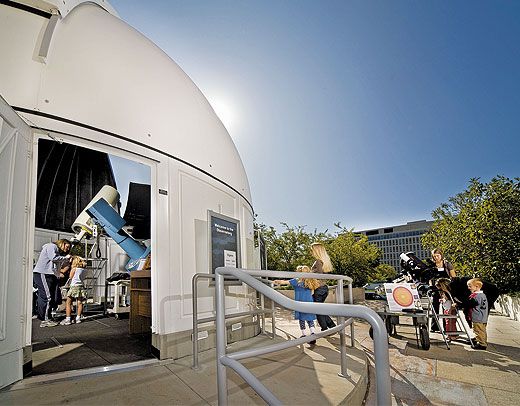In the Museum: The People’s Observatory
Bringing telescopes where the people are.
/https://tf-cmsv2-smithsonianmag-media.s3.amazonaws.com/filer/In-the_Museum_11-01-11_1_FLASH.jpg)
Clouds are the enemy.
As a line of tourists snakes across the National Air and Space Museum’s east terrace waiting to (safely) look at the sun through the observatory’s telescope, a bank of dark clouds drifts overhead.
“Could you see anything at all?” Dennis McLaughlin asks a visitor peering into the Museum’s portable hydrogen-alpha telescope sitting next to the observatory’s dome.
“A little bit,” the young man replies. “Then it started to go black as the clouds moved in. I was like ‘Oh no!’ ”
“It’s a measure of your dedication if you’re willing to wait,” says McLaughlin, one of 20 volunteers who staff the Museum’s Public Observatory Project each Wednesday and Saturday.
About 100 visitors pass through the dome each hour it’s open during the summer months. “I think they’re awed,” says Jane Mason, who has been volunteering at the observatory for a year. “There are concepts here that visitors may not think about every day, such as the size of the sun, or the idea that the sun changes.”
As the sun enters the active period of its 11-year cycle, visitors are more likely to see sunspots and other phenomena such as prominences (dense gas extended from the sun’s surface, often in the shape of a loop) and filaments (a prominence that is seen head-on, and looks like a barbed wire).
“See a tiny, wispy bump on the lower right-hand edge of the red disk?” McLaughlin asks a visitor. “That’s a prominence; the area of that might be the same as four or five Earths.”
Sunspots—which can be 1,000 degrees cooler than the surrounding area—grow as big in diameter as two or three Earths.
The observatory, which houses a 16-inch Boller & Chivens telescope, can accommodate 25 to 30 people at a time. “That was the original intent, of course: to create a public space where we could show groups the heavens,” says astronomy curator David DeVorkin.
The telescope was chosen because of its pedigree. “After Sputnik, there was an awful lot of money for the space race,” says DeVorkin. “And every university wanted a modern telescope, and Boller & Chivens was the one that became the model for technical instruction. So the reason we chose this particular model, particularly for this observatory, was that it represents the beginnings of the Space Age just as much as many of the satellites and spacecraft that we have inside. So it’s a good bit of history, in addition to being a heck of a lot of fun to use.”
The telescope was originally part of Harvard-Smithsonian’s Oak Ridge Observatory in Massachusetts. “They invited me up there to do an appraisal of the equipment,” says DeVorkin. “And we found some incredible stuff up there, very important to the history of astronomy. Most of the telescopes were late 19th century or early 20th, and they’re really very famous. But then in one dome we found this, which was purchased in the 1960s, primarily for student instruction. And we said, ‘My god, what’s going to happen with this one? It’s still a usable telescope.’ Harvard already had one on its campus for its own students. So we borrowed it. It really is a wonderful choice.”
The Museum’s observatory is occasionally open for night viewing. “We’re in the middle of the city,” says McLaughlin, referring to the problem of light pollution, “so we don’t look at the deep-sky objects so much; we look at planets.”
“That’s what people are interested in,” says Shelley Witte, an astronomy educator at the Museum. “People who have a more general knowledge of astronomy like the moon and Saturn because they’re familiar with it. Unless you know more about astronomy, a nebula’s not going to be very exciting.”
“They’re all a bunch of blobs,” jokes McLaughlin.
“Seeing the rings of Saturn or Jupiter’s moons or craters on the moon is going to be a lot more exciting,” says Witte.
The seemingly miles-long clouds have floated past, and more visitors join the line after McLaughlin urges them to take a look at the prominence looping slowly on the sun’s edge.
A middle-aged astronomy novice comes over to take a peek. She looks through the telescope and smiles. “I see it, oh, you bet.”
For more information on the Museum’s Public Observatory Project, visit nasm.si.edu/exhibitions/POPobservatory.cfm.
